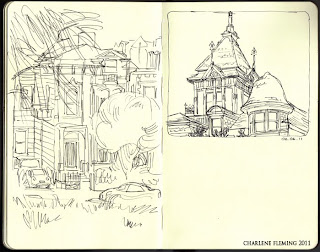
I drew these the weekend before last, intending to return the following weekend to paint them. The weather in San Francisco had been freakishly beautiful the last couple weeks but that all changed the second I stepped out to walk to the park that afternoon with my sketchbook. It was suddenly windy and cold and the clouds were rolling in swiftly despite the weather report predicting perfection. I normally just bundle up and brave the weather but in this case, the lighting was so completely different from what I needed for this specific subject that there was no point. I wound up spending the next hour walking around my neighborhood, scouting locations for future drawings. So here are some “before” images. The “after” images will have to be painted another weekend. One nice thing about painting over drawings is that it gives you a shot at correcting minor perspective blunders *cough* *cough*. I'd like to do one more drawing in that blank spot and make it a complete Alamo Square spread.
I thought I’d take the opportunity to talk about how to choose good sketching locations, which is a lot more complicated than I think most visitors to this blog realize. Today I’m just going to talk about choosing cityscapes as subjects… if I were talking about people as subjects, this would be a whole other beast.
I don’t have a car anymore so I get everywhere by bus, train, trolley, or foot. This is perfect for the artist because it means you get to spend more time actually looking at your surroundings. When a building or scene catches my eye as something that I want to draw or paint, I consider a few things:
1. Where can I sit?
2. Is there shade where I want to sit?
3. What time of day should it be for the light to be where I want it?
4. Is there a lot of traffic in front of my view?
5. Is there a lot of foot traffic going by me?
Regarding 1 & 2: Both of these are easily remedied by bringing a chair and umbrella however, it’s inconvenient and attracts unwanted passersby. If you’re in a residential area, residents may become concerned that you’re camped out in front of their house like that. I just leave my seating arrangements to serendipity, sitting on sidewalks, planters, and lampposts. I am rarely lucky enough to find a bench magically placed in view of what I want to paint. And in the right angle! Oh yeah, and if it's a hot day and you're planning on sitting in the sun, make sure not to wear black. That will hurt.
Regarding 3: I often find views I would love to paint if it weren’t for the fact that the sun was on the wrong side of it when I happened to find it. In these cases, I’ll make a note of the location (including the time I should return) for another day. This saves me time later, too, when I want to go out drawing and don’t want to waste time looking for a subject.
Regarding 4: I painted
this drawing from the front window of a café. Perfect, right? What I didn’t take into account was that I was sitting right behind a busy bus stop. The 24 Divisadero would stop right in front of me and I would have to wait until it left before I could continue working on my painting of the building that was across the street. And this was on top of already having to deal with all the regular traffic on Divisadero Street, one of San Francisco’s busiest streets. When trucks stopped at red lights in front of me, they would block the lower half of my view. In the end it was worth it but I’d like to avoid that type of experience in the future unless the view is particularly special.
Regarding 5: This is similar to 4, except in this case, your distractions actually come over to bother you. Sometimes they’re annoying, sometimes they’re crazy, and other times they’re pretty cool… sometimes they may even be fellow artists (awesome!). But mostly they’re just distracting, at best. I try not to sketch in plain view in an area with heavy foot traffic. When I feel that I need to, I make sure I wear headphones, sunglasses and the best don’t-talk-to-me face I can muster.
Other things I take into account:
How quickly is the light or weather likely to change?
How easy would it be for me to complete this is multiple sittings, if needed?
(If it’s a long session) Is there a bathroom nearby?
I don’t work from photographs. I usually take photos of my subjects for later reference after I’ve finished my paintings on the spot, in case I want to make minor changes later (but that’s rare). Any artist worth their salt can tell a painting of a photograph from a painting of a physical subject. There’s something physical that happens in our eyes and something about the way our brains process visual information that’s very different from the way the lens of a camera and a computer or the chemicals of film interpret an image. I won’t concern you with the science here… ask your local library or Google for further details. Point being, I always need to keep in mind that when doing a detailed drawing or taking that drawing to painting, I am going to be in that spot for a long time. If I’m not at least reasonably comfortable, I at least need to be somewhere I can focus or enjoy. If I’m not, my work looks hurried like I’m just trying to get it the hell over with. Anyone, artist or not, can tell when a piece of art has been enjoyed or loved.
Let me know if this has been helpful. I may try to do more tutorials and I'd welcome feedback and suggestions.







